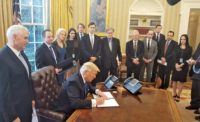Our nation’s infrastructure is no laughing matter, and infrastructure advocates are understandably frustrated. But any suggestion that we should throw in the towel is only an echo of that frustration. It also ignores our own role in the ultimate goal. The Trump administration’s 55-page document is the most detailed plan on infrastructure to come out of a White House in the modern era. It lacks the funding solution we need, but it articulates a vision in which infrastructure is treated as a connected, holistic system. Rather than knock it down indignantly, as one recent writer did on this page, we should take it as a building block for achieving our goal: modernizing America’s infrastructure so that it is built for the future and is economically competitive on the global stage.

Ultimately, the responsibility for improving our nation’s D+ infrastructure, as graded in the American Society of Civil Engineers’ 2017 Infrastructure Report Card, was never solely on the president or his administration. It lies with Congress, which over the past decade has repeatedly lacked courage beyond finding change under couch cushions to fund the Highway Trust Fund and has done little more than maintain the status quo on all areas of infrastructure. It lies with states, localities and the private sector, all of which must play a role in improving our roads, bridges, drinking water pipes, wastewater treatment centers, power lines and other infrastructure. And it lies with us: the voters—and, more importantly, engineers—as the stewards of our nation’s infrastructure. If we’re feeling frustrated, perhaps it’s because we never let our feelings lead to raising our voices and demanding action.
When I was on Capitol Hill, working on the MAP-21 surface transportation reauthorization and the Federal Aviation Administration reauthorization of 2012, the senators’ offices rarely heard from constituents or engineers about infrastructure issues. Yet, I often heard from bicyclists and those with horse trailers about the transportation issues concerning them. It’s hard to make a case that it should be the priority if our elected representatives don’t hear from anyone telling them it’s a priority. That is why each of us as engineers needs to be engaged in the political process.
Credit to President Trump
There is much work to be done to make an infrastructure plan into a legislative reality. Our Founding Fathers designed a complex process that requires legislators with varied interests to find common ground. President Trump and his team deserve credit for pushing this conversation to the forefront at the national level. Further, the president has indicated a willingness to raise the gas tax, something that far too many lawmakers shy away from—despite the fact that it is the best and most direct funding mechanism for surface transportation.
“As the agenda setter, the Trump Administration has done its part by developing a coherent proposal that offers some new policy ideas.”
– Kristina Swallow, ASCE President
As the agenda setter, the Trump administration has done its part by developing a coherent proposal that offers some new policy ideas to address our nation’s infrastructure. For these reasons, ASCE believes that the Trump administration’s infrastructure plan is a solid first step in what ultimately must be a bipartisan congressional action.
As part of the action, there are many things ASCE will be advocating for that we do not see in the Trump administration’s plan. First and foremost is a long-term, sustainable funding solution for the Highway Trust Fund. If Congress is going to put in the work to pass infrastructure legislation, this has to be the first priority, as the fund’s solvency is crucial to ensuring the federal government’s continued role in surface transportation projects.
The Trump infrastructure plan puts significant onus on states and localities for funding. While all levels of government must play a role in infrastructure investment, ASCE identifies a $2-trillion infrastructure deficit. This will not be solved without a strong federal role and true federal funding.
Improving our infrastructure must be done with a focus on preparing for the future, just as the Interstate Highway System’s creation prepared us for the last six decades of commerce in the U.S. Making strategic investments that prioritize projects with economic benefits to the country and are built sustainably and resiliently ensures we are in a position to reap the economic returns on these upgrades for decades to come.
It’s on us as engineers to support legislators at all levels of government who are committed to addressing our infrastructure needs.
If you have an idea for a column, please contact Viewpoint Editor Richard Korman at kormanr@enr.com.



Post a comment to this article
Report Abusive Comment